Filter by

Excavations on the site of the Roman town at Wroxeter, Shropshire, in 1912
This is an account of the excavations on the site of the Roman Wroxeter in Shropshire, England, undertaken in 1912. Included are descriptions of artefacts such as pottery and human remains, together with an account of the methodology used to unearth these.
- Edition
- -
- ISBN/ISSN
- -
- Collation
- -
- Series Title
- -
- Call Number
- -

Underwater Archaeology of a Pacific Battlefield The WWII Battle of Saipan
Battlefields have been the object of fascination for millions of tourists and the subjects of elaborate interpretation projects. This volume will outline the process and results of developing the WWII Maritime Heritage Trail: Battle of Saipan Project. This book will provide examples of how a group of archaeologists, managers and a community took a specific battle and transformed it from a co…
- Edition
- -
- ISBN/ISSN
- 978-3-319-16679-7
- Collation
- -
- Series Title
- -
- Call Number
- -

Uncovering Pacific Pasts: Histories of Archaeology in Oceania
Objects have many stories to tell. The stories of their makers and their uses. Stories of exchange, acquisition, display and interpretation. This book is a collection of essays highlighting some of the collections, and their object biographies, that were displayed in the Uncovering Pacific Pasts: Histories of Archaeology in Oceania (UPP) exhibition. The exhibition, which opened on 1 March 2020,…
- Edition
- Ed. 1
- ISBN/ISSN
- 9781760464875, 9781760464868
- Collation
- 614
- Series Title
- -
- Call Number
- 930.1 UNC u

Beyond Waters: Archaeology and Environmental History of the Amazonian Inland
This book is one of the outcomes of the project Cultivated Wilderness: Socio-economic development and environmental change in pre-Columbian Amazonia (http://www.cultivated-wilderness.org/). The project has particularly focused on the previously relatively unknown prehistory of the Amazonian hinterland. Our work has revealed that pre-Columbian settlements in the Santarém region in the State of …
- Edition
- Ed. 1
- ISBN/ISSN
- 9789185245607, 9789185245666
- Collation
- 129
- Series Title
- GOTARC series A, 6
- Call Number
- 930.1 BEY b

The Glass Beads of the Prehistoric and Roman Periods in Britain and Ireland
This book discusses the glass beads of Britain and Ireland. It provides a classification and chronology of beads, mainly of the Iron Age and Roman periods, but extending back into the Bronze Age. Supported by colour plates and line illustrations, it describes a series of detailed Schedules, arranged by Classes on a geographical basis and is supported by distribution maps.
- Edition
- -
- ISBN/ISSN
- 9780854312320
- Collation
- -
- Series Title
- -
- Call Number
- -

Early Anglo-Saxon cemeteries Kinship, community and identity
Early Anglo-Saxon cemeteries are well-known because of their rich grave goods, but this wealth can obscure their importance as local phenomena and the product of pluralistic multi-generational communities. This book explores over one hundred early Anglo-Saxon and some Merovingian cemeteries and aims to understand them using a multi-dimensional methodology. The performance of mortuary drama was …
- Edition
- -
- ISBN/ISSN
- -
- Collation
- -
- Series Title
- -
- Call Number
- -

A Handbook to the Palace of Minos at Knossos With its Dependencies
Sir Arthur Evans's excavation at the Cretan site of Knossos from 1900 onwards uncovered a previously unknown civilization. His enthusiastic (though controversial) reconstructions of the site and its fresco decorations made it an attractive destination for travellers and tourists, and Evans thought a simple guidebook for visitors would be desirable alongside his own multi-volume work, The Palace…
- Edition
- -
- ISBN/ISSN
- 9781107448940
- Collation
- -
- Series Title
- Cambridge Library Collection - Archaeology
- Call Number
- -

Complexity and dynamics Settlement and landscape from the Bronze Age to the …
How did people organize their settlements in later prehistoric societies? How do architecture, spatial organization, land divisions, and landscape use relate to different modes of social organization? The papers in this book contribute to a greater understanding of the complexity and dynamics of settlement and landscape organization in the Nordic countries from the Late Bronze Age to the Renais…
- Edition
- -
- ISBN/ISSN
- 9789464270440
- Collation
- -
- Series Title
- -
- Call Number
- -

Alalakh: an account of the excavations at Tell Atchana in the Hatay, 1937–1949
This monograph describes large-scale excavations undertaken by Sir Leonard Woolley from 1937 to 1939, and again from 1946 to 1949, at the site of Alalakh (modern Tell Atchana) – a late Bronze Age city in the Amuq River valley of Turkey's Hatay Province. Described is the evidence of a series of superimposed palaces and temples, town defences, private houses and graves, in 17 archaeological lev…
- Edition
- -
- ISBN/ISSN
- 9780854312177
- Collation
- -
- Series Title
- -
- Call Number
- -

Archaeology and Heritage of the Human Movement into Space
This volume addresses the creation, documentation, preservation, and study of the archaeology of lunar, planetary, and interstellar exploration. It defines the attributes of common human technological expressions within national and, increasingly, private exploration efforts, and explore the archaeology of both fixed and mobile artifacts in the solar system and the wider galaxy. This book pres…
- Edition
- 1
- ISBN/ISSN
- 978-3-319-07866-3
- Collation
- XVIII, 166
- Series Title
- Space and Society
- Call Number
- 930.1 ARC a
 Computer Science, Information & General Works
Computer Science, Information & General Works  Philosophy & Psychology
Philosophy & Psychology  Religion
Religion  Social Sciences
Social Sciences  Language
Language  Pure Science
Pure Science  Applied Sciences
Applied Sciences  Art & Recreation
Art & Recreation  Literature
Literature  History & Geography
History & Geography